For the US Air Force, the deadliest day of the war in Afghanistan so far came on April 27, 2011. USAF suffered dramatic losses not on a mountain pass or in a desert defile but, of all places, inside the home of the Afghanistan National Air Force.
Eight airmen were killed at the heavily guarded Kabul compound. The Air Force hadn’t suffered that many deaths at one time since June 25, 1996, when a truck bombing of Khobar Towers in Saudi Arabia claimed the lives of 19 airmen.
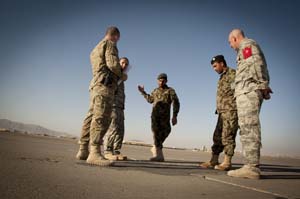
| ||
|
USAF TSgt. Gabriel Johnson (l) and SSgt. Aaron Scofield greet two Afghan men riding a motorcycle past their firefighting truck near Forward Operating Base Apache. ( USAF photo by SSgt. David Salanitri) |
This time, the attacker did not come from the ranks of al Qaeda or the Taliban. Col. Ahmed Gul, the shooter, was a supposed ally who was working in close quarters with US advisors. He was a helicopter pilot.
On that April day, Gul entered the headquarters at the Kabul International Airport. The place was filled with American and other coalition officers, civilians, and contractors, all engaged in the rebuilding of Afghanistan’s air arm.
Grave Concern
When he arrived around 10 a.m., Gul found a group of airmen gathering for a briefing in the Air Command and Control Center. Then, recalled eyewitnesses, Gul suddenly pulled a 9 mm service pistol from his belt holster and started shooting.
Out in the hallway, at least two airmen pulled their own sidearms and began firing at Gul, wounding him.
Gul moved through the building, shooting as he went. Though he spared most of the Afghans who came into his view, he wounded two. He periodically stopped what he was doing to call out the building’s window to “good Muslims,” warning them to stay away or be shot.
Coalition security forces arrived. At some point during the mayhem, the Afghan dipped his fingers into blood and scrawled on a wall, “God is one” and “God, in your name.”
Gul finally retreated up a stairway to a second floor lobby. He sat down on a couch and shot himself twice in his upper body. Those wounds were fatal.
The Kabul massacre remains the worst example yet of a pernicious brand of “friendly fire” that has emerged in the war in Afghanistan. It’s known as “green on blue” violence, in which supposedly friendly members of Afghan military and security services turn their weapons on US troops and advisors.
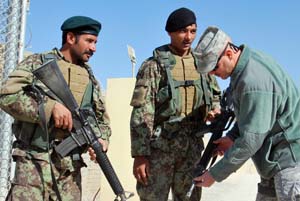
| ||
| USAF security forces work with Afghan security personnel on the flight line. ( USAF photo by SrA. Corey Hook) |
It is obviously a matter of grave concern for the International Security Assistance Force, the NATO coalition of which the US Air Force is a key part. In the shooting’s aftermath, ISAF and the Air Force alike have conducted searching investigations of the training and advising function in Afghanistan.
They have examined, among other things, active-shooter training for air advisors, emergency response procedures, and command and control techniques.
“We’ve made some adjustments to our security procedures and our footprint,” said Gen. G. Michael Hostage III, then US Air Forces Central boss, who spoke with Air Force Magazine in May 2011 about the matter.
The shooting was the very definition of a “worst-case scenario,” Hostage observed. It was almost impossible to predict, especially for personnel involved in the sensitive training and advising mission.
“It’s a matter of risk,” he said. The trainers in Kabul “were in a relatively safe environment, and so that means their guard was a bit down.”
The Kabul attack was a harbinger of future atrocities. In its wake, a wave of such attacks has beset ISAF and Afghan forces around the country.
According to the RAND Corp., green on blue violence has accounted for one in every seven NATO deaths in Afghanistan during 2012.
In August, the deadly incidents came in close succession. On Aug. 10 in Helmand province in two shootings, six marines were killed by an Afghan policeman and by a civilian worker. Three days later, an Afghan policeman opened fire on NATO troops, marking the fifth attack in a week.
These attacks are coming at a time when the US is attempting to shift over from a combat-intensive mission to one focused on training and advising—a mission requiring an extraordinary degree of trust.
Coalition leaders continually assert the attacks are “isolated incidents” in the ranks of a quickly expanding Afghan military and don’t reflect its overall dedication and professionalism.
“At this particular moment, I don’t believe that we need to contemplate reducing our contact with the Afghans,” Marine Corps Gen. John R. Allen, the ISAF commander, declared in August at the height of the attacks.
The pressure on US and NATO strategy exerted by the attacks has not relented. In late September, US officials confirmed most joint operations between Afghan and American forces have been suspended until further notice. In a statement, ISAF said it has taken “prudent, but temporary, measures to reduce our profile and vulnerability to civil disturbances or insider attacks.” As of Sept. 17, the number of attacks had risen to 36, with a death toll of 51 NATO troops.
Conflicting Reports
Allen said ISAF is putting “greater emphasis” on ensuring that coalition personnel take proper protective measures. In August, Allen authorized all coalition personnel to carry a loaded magazine with their service weapon while on base—a slight change in procedures for troops “inside the wire.”
Allen stressed that relationship-building is at the core of the coalition’s training and advising missions.
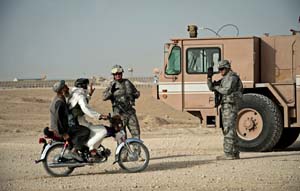
| ||
|
CMSgt. Dave Staton (r), superintendent of the 738th Air Expeditionary Advisory Group, advises Afghan security force airmen about the importance of weapons cleanliness. So far in 2012, green on blue attacks have caused one in every seven NATO deaths. ( |
“What we have learned is that the closer the relationship with [Afghan forces] the more secure … we are,” he said. Allen noted that coalition troops have tens of thousands of daily interactions with Afghans. There is, he said, “growing friendship and a deeper relationship.”
Allen’s view is echoed by top officials. Still, American leaders seeking to solve the problem say it’s hard to develop the solution when motives for attackers vary widely.
Informed officials note that only some of the attacks stem from direct Taliban coercion of Afghans or Taliban infiltration of the ranks. Many, if not most, incidents result from battle fatigue or personal grievance felt by an Afghan, they say.
Allen conceded that ISAF lacks sufficient data on the attackers to support “any kind of a definitive conclusion” about their motives.
Of the attacks recorded this year, only about 25 percent appear to be linked to Taliban activity—even though the Taliban claims credit for virtually all of them—and these Taliban cases range from direct infiltration of Afghan military units to simple blackmail.
In many cases, Allen noted, Taliban elements have coerced Afghan troops by threatening their families. In others, the violence appears more directly related to personal disagreements and animosity between an individual soldier and coalition members.
The Gul rampage offers a good example of the difficulty of establishing a motive for any particular attack. The Air Force Office of Special Investigations produced a 400-plus page report on the incident but did not pinpoint its cause.
The report said Gul never presented a disciplinary problem but occasionally voiced radical sentiments. He moved to Pakistan and then returned to Afghanistan for military service. A relative told investigators Gul made the move because he wanted to “kill Americans.” Other relatives reported he had mental problems ever since he was in a mid-1990s helicopter crash. Gul was also deeply in debt.
Gul would become angry at seemingly minor problems, said the report, but no one viewed him as a serious religious radical. Indeed, no direct contacts between Gul and the Taliban were ever established.
The green on blue violence, however, hasn’t deterred ISAF and the US from their goal of shifting to a training-and-advising footprint after 2014. The trend has led to a tightening of the vetting process for Afghan recruits in all sectors of the security enterprise.
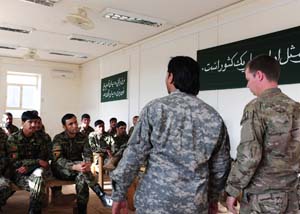
| ||
|
TSgt. Thomas Scheide (r), assisted by a translator, leads a “Level 2” training session for Afghan Air Force noncommissioned officers at Shindand AB, Afghanistan. The recent spate of violence has not deterred ISAF and the US from their goal of shifting to a training and advisory role after 2014. (USAF photo) |
In late August, after a round of meetings with top US officials at the highest levels, Afghanistan agreed to more closely monitor its own military and police recruits. This will entail the use of more undercover agents, increased surveillance of phone calls made by Afghan troops, and the banning of cell phone use among newer recruits to eliminate one possible means of communicating with Taliban handlers.
ISAF officers aren’t working on this problem in isolation. US officials note that the Afghans have put in place a new eight-step process to vet recruits for the security forces. These steps include issuing an official ID card, gathering background information from tribal elders about family members, conducting criminal background checks, screening for drug and medical problems, and collecting biometric data.
Canadian Army Brig. Gen. Thomas E. Putt, head of ISAF Joint Command’s Afghan National Security Forces Development, has seen progress in developing the Afghan military into an organization able to function at brigade and corps level. The coming months, he said, will be critical to this effort.
“My particular focus over the course of this year is to look at how to improve key enablers for the ANSF,” Putt said in a news conference on Aug. 1.
Refining, Reviewing, Enhancing
He explained that a modern military needs supporting capabilities such as a command and control system, intelligence, logistics, and anti-mine and explosive ordnance disposal units, to name a few. ISAF’s development priorities for the Afghan military, Putt said, focus on logistics, countermine tools, and the Afghan air corps.
In a rugged country with poor infrastructure, the ability to move personnel and materiel quickly—as well as to deliver ordnance—will be crucial to the survival of the Afghan security forces after NATO leaves, he asserted.
The USAF advisory mission in Afghanistan is focused on building rotary wing and light transport capabilities; some are already available for medical evacuation and troop transport for air assaults.
“They’re really just getting going in terms of what we’re looking for down the road,” Putt noted.
He said most Afghan air corps operations will be backed by ISAF air support until 2014. ISAF, meanwhile, is accelerating a program to stand up sustainable helicopter and transport squadrons.
As Putt sees it, “There is every indication that … the air force development will go on after 2014.”
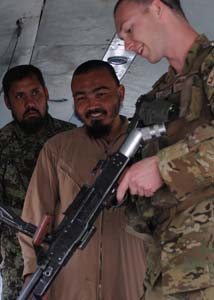
| ||
|
SSgt. Frank Reddy (r) explains the function check process for a Russian PKM machine gun to Afghan Air Force Mi-17 crew members. Recently, Afghanistan agreed to more closely monitor its own military and police recruits. ( |
Green on blue incidents strike at the core of ISAF’s transition efforts. When trainers are attacked by the Afghans who often have worked closely with coalition forces, it is a “very, very troubling” sign, said Maj. Gen. Tod D. Wolters, former commander of the 9th Air and Space Expeditionary Task Force-Afghanistan.
Commanders are looking closely at those advisory relationships, Wolters said in an August speech to the Mitchell Institute for Airpower Studies in Arlington, Va.
Some officers believe the problem should be put in the larger context of overall Afghan-coalition relations. They warn that, if overly harsh or indiscriminate measures are taken against Afghan troops or citizens, the winner will be the Taliban, which will play on popular Afghan disillusion with the war.
ISAF has been taking steps to protect its people by reassessing sleeping arrangements, internal defenses at its small forward operating locations, and the force protection posture of its forces.
Coalition forces are working with Afghan commanders and their religious and cultural affairs officers to combat the risk of personally motivated attacks. A 900-person cadre works with Afghans at the local unit level, helping overcome cultural differences.
These efforts, officials hope, will reduce those insider attacks caused by disagreements or perceived slights or other offenses.
These officers will screen Afghans returning from leave for any signs of radicalization. Had this been done in Gul’s case, it might have tipped the Afghan government and ISAF as to changes caused by his stay in Pakistan.
Air Force officials in the region won’t discuss specific force protection measures, but they say ISAF is “refining, reviewing, and enhancing” measures that meet mission needs and ensure the safety of deployed forces.
While the lessons and scars from USAF’s experience in the Gul shooting are still fresh, leaders know the training and advising mission will only gain in importance as December 2014 draws closer.
“Afghan [air] capability … is going to be a critical national element,” Hostage said. “A fully capable Afghan Air Force … ultimately represents our ticket home.”
